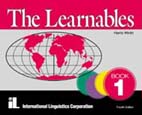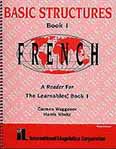

The Learnables
and Basic Structures 1 & 2
by Carmen Waggoner and Harris Winitz
Reviewed by Martha Robinson
Purchase details: The Learnables by Harris Winitz and The Learnables Basic Structures Book 1 & 2 by Carmen Waggoner and Harris Winitz. Prices differ by language and level. Audio CD's in French were reviewed. Published by International Linguistics Corporation. Please support HomeschoolChristian.com by buying this program from our Amazon affiliate link.
Promising results for children as young as five, The Learnables offers a unique immersion approach to learning a foreign language. The principle behind The Learnables is that the language should be heard and understood before it is spoken and before grammar and other written forms of the language are learned. Associates of International Linguistics Corporation, publishers of The Learnables, have overseen research and published results that show that the method works.
Level I consists of a 48-page, staple-bound paperback lesson book and audio tapes or CD's. The written instructions at the beginning of the lesson book give an overview of how to use the program and instruct the user to begin by listening and learning the numbers from one to ten in the foreign language. Students are asked not to speak, because it will not help in their understanding and may cause them to mispronounce words. According to the authors, "Good speech requires good listening."
Each of the ten lessons in Level 1 has ten pictures with a number by each picture. The native speaker on the audio says the number of the picture and a word, phrase, or sentence that describes it. The description, frequently a noun with adjectives or a simple sentence, is said two times. Sound effects such as laughing, walking, car/airplane noise, and a squeaky door are played on many of the frames that show action. The pictures are simple line drawings placed twenty-four to a page. There are no written words in Level I other than the instructions in English.
At the end of even numbered lessons a 10-question, multiple choice test appears. Students listen to the audio and select from three pictures. Answers are in the back of the book. The authors recommend that the student do each lesson two to three times.
The CD's are good quality with a female, native French speaker. Four CDs are used in Level I , and each track is labeled on the back of the CD case for easy reference.
Basic Structures, a 140-page paperback, should be studied after completion of Level I. Once again, simple line drawings are shown, but in this volume, the pictures are larger, easier to see, and have written phrases or sentences below them.
Lessons in Basic Structures are correlated with lessons in Level I. In the "revision" sections material studied in Level 1 is reviewed, but the words and phrases learned are put together to make more complex phrases and sentences. Numerous "look, listen, and read" exercises ask the student to listen to the audio while looking at the written words and to match the correct words to the picture. The instructions say to write the correct number in the book, but of course, the student could write the answers on a separate paper to make this volume reusable. Basic story lines about naughty babies and happenings at restaurants and airports add interest to the material.
Beginning with lesson 7, "expansion" sections introduce the student to more complex sentences and additional vocabulary not covered in Level I. As before, the number of the picture and the phrase or sentence are read.
Each lesson ends with a quiz in which the student writes the correct word according to the context of the sentence. This section does not have an accompanying audio.
A review section is at the end of the tenth lesson. Six sections review the vocabulary and sentence structures from the Basic Structures, and then three exercises are provided.
Basic Structures ends with a page of translations of the instructions, an answer key for all of the exercises, and a listing of the vocabulary introduced by lessons in both Level I and Basic Structures.
Four CDs are used in Basic Structures. Again a female native speaker and sound effects are used. A listing of the location of lessons by track is shown on the back of the CD case.
Level I is also available in Spanish, German, Russian, Mandarin Chinese, Hebrew, Japanese, and Czech, while the Basic Structures book is available only for Spanish, German, Russian, and Hebrew. Completion of Level I and Basic Structures will give the student the equivalent of one year of high school foreign language.
The Learnables Book 2 continues in the same way as the first level but with increased complexity. The student text is a 58-page paperback with small line drawings. Lessons are numbered from eleven to twenty with two supplemental lessons numbered 19x and 20x. A French man and woman alternate with narrating duties, while additional voices are introduced during the many conversations in this level. Many sound effects, such as items being set on a table, a phone ringing, footsteps, and kisses, add interest.
Questions and commands are emphasized from the first. While most of the frames have just one sentence, some include two sentences. Story lines are carried through several frames or even through an entire lesson, and many include robbers who are always caught by the police in the end. Conversations allow for questions to be answered and for the characters to retell, in the past tense, what happened to them in previous frames.
Vocabulary from book one is used along with many additions. Everyday happenings such as brushing teeth, getting dressed, going to bed, cooking, travelling, visiting the beach, shopping, eating at a restaurant, seeing the doctor, and going to the veterinarian are acted out in the program. At one point two old ladies discuss a painting of a nude at the museum. They say that it is horrible, but a little girl who looks at it laughs. (Everything is covered in the sketches in this segment.) The retellings of the story lines allow for reinforcement of vocabulary as well as comparison between present and past tenses. Prepositions and questions such as Where?, What is?, and May I? are also included. The supplemental units, 19x and 20x, give intensive work in pronouns and prepositions and review other concepts from past lessons.
The Learnables Basic Structures Book 2, with almost 400 pages, offers the opportunity for a tremendous amount of learning. The pictures are larger than in the basic program and additional shading helps make the pictures clearer. A diversity of ethnicities are represented in the pictures.
Lessons corresponding to the lessons in The Learnables Book 2 are divided into review, expansion, and exercises. Each section has native French speakers reading the phrases and sentences, and multiple voices are used for conversations. Lessons 19x and 20x from Book 2 are combined into one lesson in Basic Structures Book 2.
The review sections repeat many of the phrases from Book 2, but show them in writing with numbers that match the pictures. Students are asked only to listen to the review. Any words that the student may have missed or situations where words are merged in spoken language are clarified. Differences between words and sentence types are shown by contrasts. For example, in lesson 17, review 4, the frames have a command, Enter the car. followed by a statement, He enters the car. Another frame shows the command, Get out of the car. and the statement, He gets out of the car. Each lesson has from one to six review sections.
The expansion section builds upon the phrases memorized in the previous book. Again contrast is frequently used to give students an understanding of grammar concepts. For instance, in lesson 16, expansion 5, objective pronouns are illustrated through sentences that translate, He touches her, He touches him, He touches himself, and She touches him. Negatives are illustrated in lesson 20, expansion 1 with the first frame illustrating, The man is a doctor, and the second frame showing, The man is not a doctor. The number of expansions per lesson ranges from seven to thirty-seven.
The exercise section gives the child a chance to see if he or she remembers the material. Most of the exercises ask the student to match a sentence with a picture, but Learnables Basic Structures Book 2 introduces readings that describe a picture and are followed by comprehension questions. Parents will need to check these with the answers in the back of the book. The final exercise of each lesson is a brief fill-in-the-blank test that is not narrated. All of the chapters except one have more than twenty exercises with some having as many as thirty-six.
Recommendation: The best way to learn a foreign language is through an immersion program with native speakers. The Learnables offers such a program. While the pictures in the Book 1 and Book 2 would be easier to see if they were a bit larger, they allow the youngest children to begin studies in foreign language, when learning language is the easiest.
The Learnables will be excellent for auditory students. With the audio and picture connections, the student is sure to learn quickly. Visually oriented students will find the pictures helpful and will pick up the written form of the words during study in the Basic Structures book without wondering why all the consonants are not sounded out in French.
The Learnables requires the student to sit still and look at the book while listening. As each lesson in Book 1 takes about twenty minutes to complete while the Basic Structures and Book 2 lessons take longer, you may want to consider if your child has the attention span for this program. The authors suggest that you sit with younger children to help maintain their focus. Because of its method, I believe this program would be outstanding for use in the car. In the review copy provided, I found several typographical and production type errors, but they are only minor distractions and do not affect the content of the program. The editor of The Learnables has informed us that these errors have been corrected.
Some children might find the repetition in Book 1 and Book 2 to be a bit tedious, but they will likely find the Basic Structures books to be much more stimulating. The expansion sections add interest, and the exercises give the child a chance to do more than listen. I particularly like the readings in Book 2 with questions asking for student responses.
The approach used in The Learnables is not traditional. Parts of speech, gender of nouns, and verb conjugations are not mentioned in any of the books. If you are convinced that traditional textbook approach is best, this is not the program for you. On the other hand, if you are looking for a primarily auditory program with relatively short lessons and an excellent foreign accent, The Learnables should certainly rank high in your consideration.
HomeschoolChristian.com resources related to this review:
Review of The Learnables Bible Stories
Review of Power-Glide Children's French
HomeschoolChristian.com's Foreign Language Resources Section
Find more helpful reviews on HomeschoolChristian.com's Review Page Index!
Reviews represent the opinions of the authors rather than the views of HomeschoolChristian.com.



